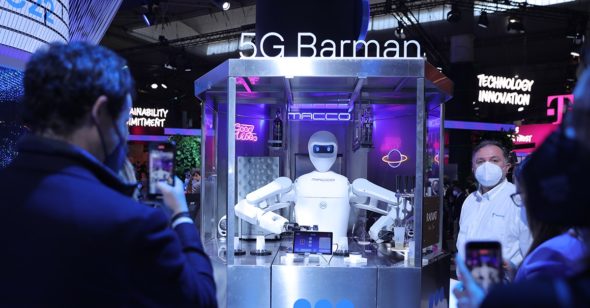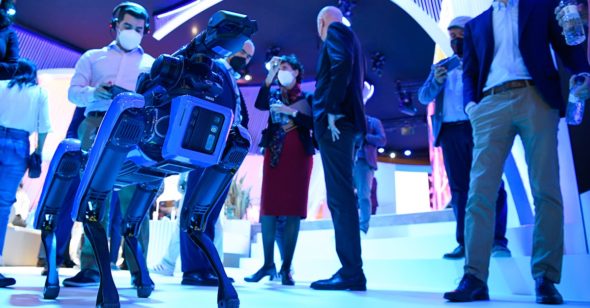
MWC Barcelona was back with a bang for its 2022 edition, with over 61,000 attendees from almost 200 countries joining the event in-person. Over four days, more than 1,900 companies joined MWC22 to showcase the role of mobile technology in unleashing connectivity and advancing 5G, AI and the internet of everything.
In addition to the 61,000 people attending in person, there were around 500,000 unique virtual and daily viewers on MWC22 and partner platforms and over 1,000 speakers, 97 per cent of whom participated in person. The event was shaped by six core themes: 5G connect, advancing AI, cloudnet, fintech, internet of everything and tech horizon.
GSMA, the organisers of the event, reflected on the week in Barcelona. John Hoffman, CEO, GSMA, commented, “Nothing beats MWC in person, and it was exciting to bring our community – which is so passionate about connectivity – back together to discuss the opportunities that lie ahead. On behalf of the GSMA, I would like to thank all of our attendees, exhibitors, sponsors, and partners who came together to make MWC22 so productive, safe, and successful.”
Standout keynotes
During MWC Barcelona 2022, Huawei’s rotating chairman Guo Ping spoke on the company’s plan to continue its globalisation strategy and increase its strategic investment into foundational technologies. Through this investment, Guo explained, Huawei hopes to reshape the fundamental theories, architecture, and software that underpin the industry, increase its mid-to long-term competitiveness, and ensure the long-term sustainability of the ICT industry.
In his keynote speech, titled “Just Look Up, Let’s Light Up the Future”, Guo focused on two major sources of both challenge and opportunity in the world: digitalisation and carbon neutrality. He also reflected on network evolution over the past decade, ranging from IP, to cloud, and then to AI today. Guo said that Huawei is confident it will be able to gain a head start in the evolution towards future AI-native networks. He added, “Huawei will continue its globalisation strategy, in standards, talent, supply chain, and more. Huawei is committed to helping customers who choose it to achieve the greatest business success.”
Cristiano Amon, president and CEO, Qualcomm, took the stage to reveal the newest additions to the company’s technology roadmap. Among his key announcements were the world’s first and fastest Wi-Fi 7 commercial solution, the world’s first 5G AI processor in a modem-RF system, and expanded capabilities around end-to-end MPNs, integrated OpenRAN, and mmWave deployments.
FastConnect 7800 brings together high-speed, ultra-low latency Wi-Fi with the latest Wi-Fi 7 specification. It introduces High Band Simultaneous (HBS) Multi-Link technology, which delivers the highest throughput and lowest sustained latency, while reserving high-traffic 2.4GHz spectrum for Bluetooth and lower-bandwidth Wi-Fi. The Snapdragon X70 5G Modem-RF System is the company’s fifth generation modem-to-antenna 5G solution. It delivers 10 Gigabit 5G downloads and upload speeds, low latency, coverage, and power efficiency. The company said these capabilities offer flexibility to global 5G operators to maximise spectrum resources for the best possible 5G connectivity.
These advancements are designed to power next-generation experiences while accelerating digital transformation across key segments including mobile computing, XR, automotive, industrial IoT, 5G networking, and wireless fibre. Qualcomm said these connectivity, high-performance, low-power computing and on-device AI innovations position Qualcomm to drive the realisation of the connected intelligent edge.
Amdocs, a provider of software and services to communications and media companies, was showcasing its suite of cloud-native solutions and services at the event. Shuky Sheffer, Amdocs President and CEO, participated in the Delivering a New World keynote where he discussed 5G opportunities in a fireside chat with Stephanie Lynch-Habib, CMO at the GSMA.

Optimising connections
On the exhibition floor, wireless edge networking specialist Cradlepoint launched Cradlepoint Cellular Intelligence. This new offering is designed to simplify management of LTE and 5G wireless deployments for businesses. The features can help enterprises orchestrate and optimise connections, data plans and the traffic of their cellular networking deployments from a single interface. Cellular Intelligence includes live stats and health dashboards broken out by carrier and network type, cellular signal mapping and SD-WAN. Cellular Intelligence is available now through Cradlepoint’s channel partners.
Dell Technologies debuted the Dell Telecom Multi-Cloud Foundation, a modern network infrastructure offering that aims to help cloud service providers build and deploy open, cloud-first networks faster with less cost and complexity. The Telecom Multi-Cloud Foundation includes Dell hardware, Dell Bare Metal Orchestrator management software and the provider’s choice of integrated telecom cloud software platforms, including Red Hat, VMware and Wind River.
Cisco announced details on its go-to-market strategy for Cisco Private 5G. The foundation of the solution is built on Cisco’s mobile core technology and IoT portfolio – spanning IoT sensors and gateways, device management software, as well as monitoring tools and dashboards – with Open Radio Access Network (ORAN) technology a key component of the solution.
At the event, Cisco announced that it is collaborating with ORAN vendors, JMA and Airspan on customer trials utilising Cisco’s technology. The vendor explained that key differentiators of Cisco Private 5G for Enterprises include as-a-service delivery, integrations with existing enterprise systems (including Wi-Fi 5/6/6E), and visibility across the network and devices using a management portal.
Cisco added that Cisco Private 5G partner benefits include a quicker path to profitability, given partners can reduce the required time, energy, and capital to deliver private 5G offerings. Partners can also white label the Cisco Private 5G on a subscription basis. In addition, partners may enhance Cisco Private 5G with their own value-added solutions.
NTT Data presented a number of solutions at the event, which centred on 5G and operative efficiency. The company said its strategic vision in the telecommunications sector can be split into these two categories.
Sharad Sharma, head of networks at NTT Data UK, commented, “5G dominated the agenda at Mobile World Congress once again, but this year featured a renewed focus on apps. There is a clear market need to streamline the building process for custom build apps, and NTT Data’s ability to build apps with low code technology makes it easier for industries to adopt and leverage private 5G networks to transform their operations.
“We are entering a period of transformation with 5G, and now is the time for businesses to embrace the technology, rather than waiting for the perfect app. The cutting-edge solutions we saw on display at MWC 2022 show we are at a turning point, where technological innovation and 5G can bring transformation for both businesses and wider society.”

Product advancements
Amdocs introduced CES22, the most advanced version of the Amdocs Customer Experience Suite. The product includes the latest technologies for service providers to accelerate growth, diversify their business, introduce, and monetise innovative and advanced services for both consumers and businesses. The product is designed to help introduce new business models adapted to the partner-powered economy and the metaverse.
Anthony Goonetilleke, group president of technology and head of strategy, Amdocs, explained, “In a world where connectivity is increasingly critical, it’s essential that service providers are able to provide next-generation experiences to their customers, however and wherever they connect. CES22’s end-to-end capabilities across business, IT and network systems ensure that our customers provide their end users with superior and frictionless experiences.”
Enreach showcased its mobile-first communications and collaboration solutions, delivered from its multi-tenant UCaaS platform. At the event, the company spotlighted solutions for MNOs, MVNOs and service providers who aim at adding mobile VAS to their fixed-line portfolio.
Enreach said its Mobile Cloud PBX enables mobile operators and MVNEs to offer enterprise mobile users the advanced features of an office telephone on their mobile over existing networks. In addition, it has a white label mobile app for business collaboration and productivity and a FMC router that enables MVNOs to offer FMC services to fixed line operators.
Powerful connectivity
Elsewhere, Nokia announced the launch of Adaptive Cloud Networking, a cloud-native solution to transform service provider cloud networks to be consumable, agile and automated. The solution is designed to respond to the unpredictable demands of the 5G era by supercharging a service provider’s data centre fabric and seamlessly extending its operations to the edge clouds. The company expects this innovation in the way telco clouds are built and operated to enable service providers to reinforce their critical role in the 5G digital network value chain.
Paul Parker-Johnson, chief analyst and practice lead for cloud and virtual system infrastructures, ACG Research, explained, “Delivering cloud-native networks and application services effectively in the future will rely on enhanced data centre fabrics built from the start for cloud-native operations, from core to edge. Cloud-native networking fabrics need a strong foundation of open, standards-based protocols and data models, broad software modularity, dynamic and complete alignment with service intent, and rich automation at every layer of operation. Nokia has heard these requirements from customers clearly and its solution incorporates what is most important for use in service providers’ distributed clouds. Combined with its experience delivering solutions at scale in operator mobile, IP/MPLS/Segment Routing, edge, and SD-WAN deployments, and use of rich automation in each of those domains, Nokia’s Adaptive Cloud Networking presents an innovative, scalable, and agile solution to use as the foundation of operators’ cloud-native services.”
Vach Kompella, vice president, IP networks division, Nokia, added, “Nokia’s Adaptive Cloud Networking is about automating every phase of the data centre fabric and network lifecycle, including design, deployment and operations. Intent-based automation capabilities can be implemented every step of the way, supercharging service provider operational productivity without having to expand staff and skill set. We’re pleased to offer service providers a complete solution that will help them transform their business both now and into the future.”
Ericsson unveiled new products ahead of the event, with energy efficiency updates to its 5G RAN portfolio. The flagship product is Radio 4490, a dual-band radio that delivers 25 per cent lower power consumption and lesser weight compared to the current product. This radio type is compatible with most of the radio sites globally as it supports the main FDD bands being used by many service providers for their 5G deployment. In addition, Ericsson is launching a high-power version of the new dual-band radio, 4490 HP, which enables up to 50 per cent more output power compared to current radios. The two new radios apply passive cooling (which reduces power consumption as fans are not needed) as well as being Cloud RAN-ready.
Per Narvinger, head of product area networks, Ericsson, said, “We continue to evolve our RAN portfolio with more solutions for smart, slim and sustainable 5G networks. Our latest innovations will further optimise 5G sites for both purpose-built and cloud RAN deployments.”
Ed Gubbins, principal analyst at Global Data, explained, “With this launch Ericsson has shown its commitment to sustainability through energy-efficient products and solutions for 5G rollouts and site expansions. Ericsson’s recipe includes in-house silicon, innovative radio and antenna product engineering, and advanced software features.”
At MWC, Xilinx demonstrated the breadth of its 5G O-RAN offerings. That includes its 5G O-RAN mMIMO radio 64T64R prototype with Keysight Technologies’ DU emulator, and an open 5G VRAN platform demo complete with a telco accelerator card and CU-DU units running to an AMD server. VRANs like these offer operators improved efficiency and flexibility to meet the growing performance and latency demands of 5G customers. The company’s O-RAN solutions are based on open standard specifications defined by the O-RAN Alliance, and are complimentary to 3GPP standards. O-RAN specifications are designed to help build a more competitive supplier ecosystem with faster innovation.
Gilles Garcia, senior director of the WWG business unit at Xilinx, explained, “Xilinx has been at the heart of the telco infrastructure for years, improving workload performance and scalability in basestations and radios as well as the wireless core network, and accelerating applications at both the edge and cloud. Now helping to drive broad industry adoption of 5G technology, we are offering a wide array of O-RAN solutions ranging from a massive MIMO radio prototype, RFSoC devices for single-radio chip design, and telco accelerator cards to VRAN solutions for private 5G networks,” he added.

Global digital policy
GSMA presented a ministerial programme which focused on the global digital policy debate. Participants from more than 160 delegations from countries and international institutions around the world – including policymakers, regulators, industry leaders, and the international development community – exchanged experiences and views on how to build policies for a digital world.
The programme included discussion on how to maximise the potential of 5G, close the digital gap, and meet global climate targets. There was broad agreement that more collaboration and cooperation is required amongst all stakeholders to expand digital inclusion for all. This year, leaders including Jessica Rosenworcel, Chairwoman of the U.S. FCC, and Minister Paula Ingabire of Rwanda, contributed to the conversation and brought their policy priorities to the MWC keynote stage.
During a keynote session on spectrum strategy for 4G, 5G and beyond, John Giusti, chief regulatory officer at GSMA, said, “As we look forward to the next five years, we expect that 80 per cent of the world’s mobile connectivity will be 4G or 5G. we know that 5G will be central feature of the next phase of global economic development. 5G will automate our factories, connect our cities and transport, and provide innovation healthcare and education.
“Of course, spectrum access is the starting point for any mobile network, and each new generation comes with its own spectrum needs. We recognise that today’s spectrum assets won’t be enough to meet this demand and we need to look forward to how to ensure sufficient capacity for both urban and rural areas to realise the promise of 5G. we cannot bridge the digital divide unless we use our resources as efficiently as possible.”
Roberto Nobile, CEO of Telecom Argentina, highlighted why the spectrum debate is so crucial to 5G delivering on its potential. He said, “Spectrum is the raw material. It’s the enabler to more connectivity, growth and value creation.”
Andrew Lloyd, vice president, head of government and industrial relations, Ericsson, added, “Six billion people are now connected across the planet [unique mobile subscribers]. We now have over eight billion [mobile] subscriptions – that is a remarkable achievement. And that is thanks to the people in this room, the regulators, setting the policy direction, but in a technology-neutral way and letting the market decide what’s the best solution for each of the demands and sue cases.”
Industry City was a new component for MWC22 and included demos from the fintech, manufacturing, and automotive sectors. Visitors had the opportunity to experience a range of summits covering robotics and smart mobility topics through interactive metaverse tours and demonstrations from partners and the GSMA Foundry programme.
In addition, the entrepreneurial startup community returned to the event with the 4YFN (Four Years from Now) programme. 4YFN welcomed over 500 international startups and over 300 speakers to share insights on how to drive the ecosystem forward. During the event, 200 startups pitched to leading funds, VCs, and CVCs in a bid to secure a slice of more than €24 billion of investment.
The analyst view
GlobalData found that dozens of players from across the tech landscape formally entered or strengthened their position in the private 5G market at this year’s event, despite telco operators previously resisting deploying private 5G/LTE networks. John Marcus, principal analyst at GlobalData, explained, “Telcos initially resisted the trend of private LTE and 5G networks, preferring instead to monetise their public network investments while testing B2B use cases such as connected car and smart factories. Given the scale of investment involved in 5G networks, the return-on-investment cycle is lengthy, and potentially threatened by dedicated private network solutions.
“Such networks are enabled by privately owned or unlicensed spectrum, meaning that a telco is not necessarily needed to create one, which has led to hardware vendors, system integrators, and cloud providers all getting in on the action. Even enterprises themselves can theoretically deploy their own private 5G network given the solutions available.”
Marcus pointed to vendors including HPE and Cisco making their first significant moves in private 5G networks, with a number of telco operators announcing new services or collaborative partnerships for private 5G and the related area of edge computing. Operators in the US, the Middle East, Asia, and Australia launched new efforts in private 5G and edge, including the largest incumbents in some of those markets.
Marcus added, “We have already observed European telcos enter the space, however, seeing operators from around the globe ‘give in’ to private 5G as the solution resonating most with today’s digitally transforming enterprises is notable, given the recent resistance of many of them.”
Maintaining momentum
Mats Granryd, director general, GSMA, summarised the event and discussed the shape of things to come. He said, “The momentum leading into MWC22 was palpable, and it delivered. In the spirit of our theme Connectivity Unleashed, we saw how industries were going beyond simple connectivity to deliver meaningful connectivity, deploying technology in ground-breaking ways that will shape industry and society.
“I thank every person who helped make MWC Barcelona 2022 an unmissable event – and as we move to a ‘digital everything’ world, I look forward to seeing what we achieve next year!”
